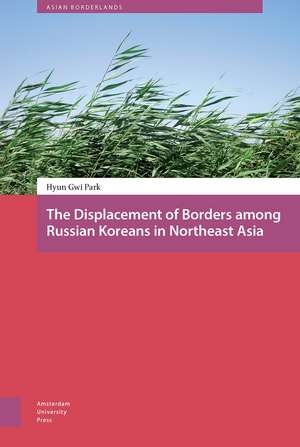The Displacement of Borders among Russian Koreans in Northeast Asia: Asian Borderlands
Autor Hyun Gwi Parken Limba Engleză Hardback – 6 dec 2017
Since the nineteenth century, ethnic Koreans have represented a small yet significant portion of the population of the Russian Far East, but until now, the phenomenon has been largely understudied. Based on extensive historical and ethnographic research, this is the first book in English to chart the contemporary social life of Koreans in the complex borderland region. Dispelling the commonly held notion that Koreans were completely removed from the region during the country’s attempt to “cleanse” its borders in 1937, Hyun Gwi Park reveals timely new insights into the historical and current experiences of Koreans living along the Eurasian frontier.
Preț: 555.57 lei
Preț vechi: 847.04 lei
-34% Nou
Puncte Express: 833
Preț estimativ în valută:
106.31€ • 113.68$ • 88.64£
106.31€ • 113.68$ • 88.64£
Carte indisponibilă temporar
Doresc să fiu notificat când acest titlu va fi disponibil:
Se trimite...
Preluare comenzi: 021 569.72.76
Specificații
ISBN-13: 9789089649980
ISBN-10: 9089649980
Pagini: 212
Ilustrații: 14 halftones, 7 line drawings
Dimensiuni: 152 x 229 x 20 mm
Greutate: 0.5 kg
Editura: Amsterdam University Press
Colecția Amsterdam University Press
Seria Asian Borderlands
ISBN-10: 9089649980
Pagini: 212
Ilustrații: 14 halftones, 7 line drawings
Dimensiuni: 152 x 229 x 20 mm
Greutate: 0.5 kg
Editura: Amsterdam University Press
Colecția Amsterdam University Press
Seria Asian Borderlands
Notă biografică
Hyun Gwi Park is a research fellow of Clare Hall and a research associate in the Faculty of Asian and Middle Eastern Studies at the University of Cambridge.
Cuprins
Acknowledgements
Note on transliteration, translation, and names
Preface
Clearing the ground
Introduction: the obscure presence of Russian Koreans in Northeast Asia
Displacement and mobility
Encounters
‘Wounded attachment’
Russian Koreans and Soviet disengagement from the Asia-Pacific frontier
Unity and diversity
Fieldwork and outline of chapters
1 The history of ‘Korean question’ and border-making in the Russian Far East
An early crossing: the flight from hunger
The formation of a border and the beginning of regulation (1884-1904)
The Korean question and the ‘yellow peril’
Internal diversification of Korean settlers and the anti-Japanese movement
Building Soviet socialism and cleansing the Soviet Far East
Memory in silence in the present
2 Repatriating to the Russian Far East, confronting the transition
Early repatriates: returnees from Central Asia in the 1950s
Newcomer Koreans in the early 1990s: ‘organized’ migration in chaos
From migrants to traders in the mid-1990s
Late newcomers and problems with documents
The notion of ‘locality’ for newcomer and old resident Koreans
3 Living Soviet socialism the Korean way: mobile agriculture at the border of socialism
Rice cultivation: socialist peasants in Soviet Central Asia
Work vnye (‘outside’) the system: gobonjil during Soviet times
Nomadic socialist peasants in the lacunae of Soviet socialism
Trading cultivators or cultivating traders: trading political status with economic wealth
One’s own people in/outside the Soviet system
Living on the border of Soviet socialism
4 Greenhouse society: the subsistence economy and house-holding
The economic conditions for greenhouse cultivation
Greenhouse construction and the preparation of young plants indoors
The greenhouse as threshold
The greenhouse in gendered terms
The extended space of the house
Food: everyday meals and ceremonial banquets
The transformation of women in the continuity and extension of the house
Becoming persons
5 Recalling history: Koreiskii Dom, transnational connections, and diaspora politics
Koreiskii Dom as a stage for diasporic politics
Leadership change and its implications
Different visions for a Russian Korean collective identity
Epilogue
Appendix 1
Appendix 2
Glossary
Bibliography
Index
Note on transliteration, translation, and names
Preface
Clearing the ground
Introduction: the obscure presence of Russian Koreans in Northeast Asia
Displacement and mobility
Encounters
‘Wounded attachment’
Russian Koreans and Soviet disengagement from the Asia-Pacific frontier
Unity and diversity
Fieldwork and outline of chapters
1 The history of ‘Korean question’ and border-making in the Russian Far East
An early crossing: the flight from hunger
The formation of a border and the beginning of regulation (1884-1904)
The Korean question and the ‘yellow peril’
Internal diversification of Korean settlers and the anti-Japanese movement
Building Soviet socialism and cleansing the Soviet Far East
Memory in silence in the present
2 Repatriating to the Russian Far East, confronting the transition
Early repatriates: returnees from Central Asia in the 1950s
Newcomer Koreans in the early 1990s: ‘organized’ migration in chaos
From migrants to traders in the mid-1990s
Late newcomers and problems with documents
The notion of ‘locality’ for newcomer and old resident Koreans
3 Living Soviet socialism the Korean way: mobile agriculture at the border of socialism
Rice cultivation: socialist peasants in Soviet Central Asia
Work vnye (‘outside’) the system: gobonjil during Soviet times
Nomadic socialist peasants in the lacunae of Soviet socialism
Trading cultivators or cultivating traders: trading political status with economic wealth
One’s own people in/outside the Soviet system
Living on the border of Soviet socialism
4 Greenhouse society: the subsistence economy and house-holding
The economic conditions for greenhouse cultivation
Greenhouse construction and the preparation of young plants indoors
The greenhouse as threshold
The greenhouse in gendered terms
The extended space of the house
Food: everyday meals and ceremonial banquets
The transformation of women in the continuity and extension of the house
Becoming persons
5 Recalling history: Koreiskii Dom, transnational connections, and diaspora politics
Koreiskii Dom as a stage for diasporic politics
Leadership change and its implications
Different visions for a Russian Korean collective identity
Epilogue
Appendix 1
Appendix 2
Glossary
Bibliography
Index











